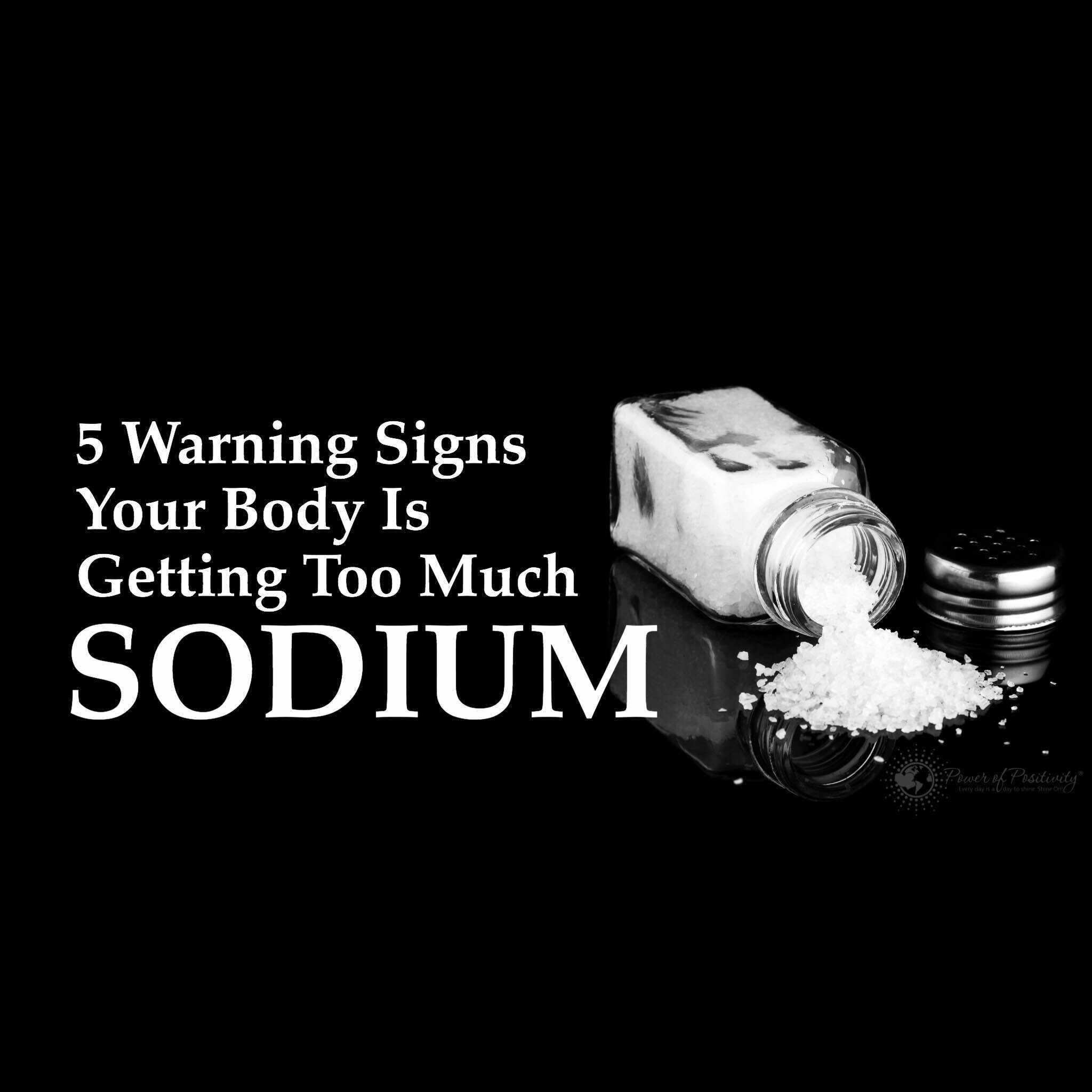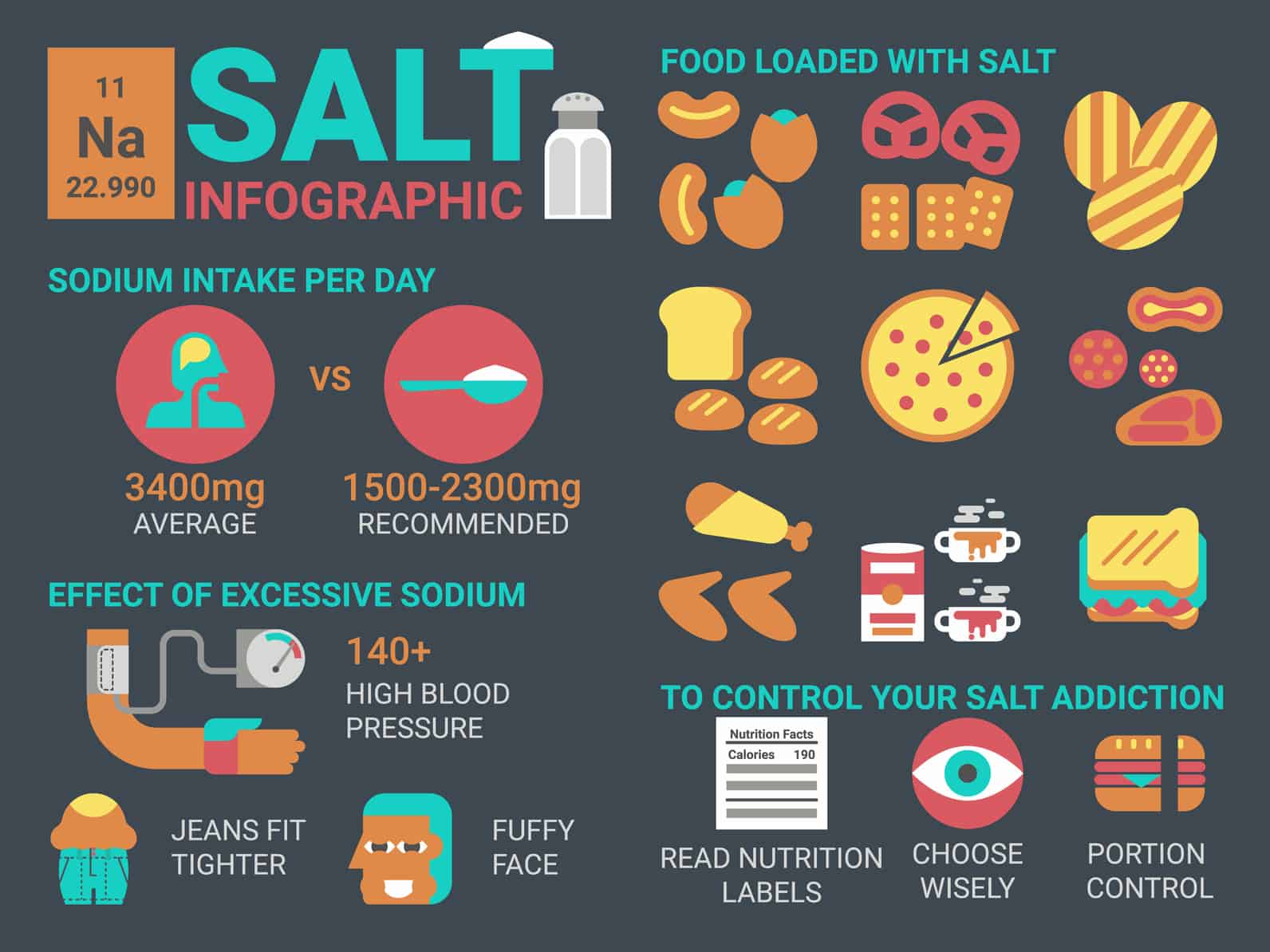Sodium (salt) is a necessary mineral for the human body to ingest. It effectively supplies electrolytes and maintains the fluid levels within our cells. It is also essential to the healthy transmission of nerve impulses within the body. Further, sodium plays a key role in the digestion of food.
The problem is that most of us simply eat too much. The Recommended Daily Intake (RDI) of sodium varies from one source to the next, but falls between the ranges of about 1,500 to 2,400 milligrams (mg) – about 3 to 5 grams of table salt. For example, Canada’s governmental health agencies recommend a maximum of 1,600 mg, while the United States government recommends a maximum of 2,300 mg.
Salt Intake Recommendations
Here is the breakdown of the U.S. governmental health agencies and their recommended intake:
-United States Department of Agriculture (USDA): 2300 mg.
-American Heart Association (AHA): 1500 mg.
-Academy of Nutrition and Dietetics (AND): 1500 to 2300 mg.
-American Diabetes Association (ADA): 1500 to 2300 mg.
The recommended amount from the American Heart Association (AHA) is an interesting statistic. Why’s that? Because excessive sodium intake directly results in a greater chance of heart disease, heart attack and other heart-related problems. Here’s what WebMD has to say:
People with heart failure may improve their symptoms by reducing the amount of salt (sodium) in their diet. Eating too much salt causes the body to retain too much water, worsening the fluid build-up associated with heart failure.
The majority of our sodium intake comes in the form of processed foods. For those that need a refresher, processed food has transformed from the raw form either to extend shelf-life – such as the freezing or dehydration of fruits and vegetables – or to improve consumer’s palatability of (taste for) raw commodities – such as transforming grain and animal products into bakery and meat products.
Americans’ average intake of sodium is around 3,400 mg – most of it comes from these same processed foods.
For comparative purposes, let’s look at the sodium content of fresh, raw food versus the processed variety.
For those that eat meat, processed meats contain roughly 400% more sodium than the natural product. Much of this is due to the curing, smoking, drying, canning, and salting of the original product. Processed meats have been directly linked to cancer by the World Health Organization.
Let’s take a look at some examples of raw, natural vegetables and their associated sodium content.
Asparagus (10 spears) / 10 mg
Avocado (1/2 medium) / 10 mg
Green beans (1 cup) / 4 mg
Carrot, cooked (1/2 cup) / 52 mg
Corn, boiled (1/2 cup) / 14 mg
Mushrooms, chopped (1/2 cup) / 1-2 mg
Onion, chopped (1 cup) / 2-3 mg
Spinach, raw (1/2 cup) / 22 mg
Sweet potato (1 small) / 12 mg
Tomato (1 medium) / 11 mg
Now, let’s look at the processed variety and its sodium content. (Please note: some serving sizes had to be approximated for comparative purposes.)
Asparagus, canned (1/5th can) / 142 mg
Green Beans, canned (1 cup) / 800 mg
Carrots, canned (1/2 cup) / 295 mg
Corn, canned (1/2 cup) / 351 mg
Mushrooms, canned (1/2 cup) / 331.5 mg
Onion, canned (1 cup) / 117 mg
Spinach, canned (1/2 cup) / 29 mg
Sweet potato (1 cup) / 191 mg
Tomato (1 cup ) / 307 mg
Obviously, the processing of vegetables dramatically increases the product’s salt content. This goes for other products that are canned or packaged, as well. A simple search will reveal this fact. Now, let’s discuss the dangers of ingesting too much salt.
Here are 5 signs you may be consuming too much sodium:
1. Inflammation and weight gain
Sodium is predominantly concentrated on the outside of our cells. When the amount of sodium available in these areas is excessive, this causes the kidneys to reduce the amount of water released into the urine. The result is increased water retention and edema (or swelling) in various parts of the body. Further, although sodium does not directly correlate with fat gain, it does increase water weight that will show up on the scale.
2. Kidney stones
Excessive sodium, often from salt, results in the kidneys having to excrete more calcium into the urine. A high concentration of calcium will often combine with other minerals – such as oxalate and phosphorous – which will then harden and form “stones.” Since sodium intake is excessive is most people’s diets – combined with the importance of calcium, something most people don’t get enough of – it is recommended that we reduce the amount of sodium ingested by altering our diets. Further, calcium is an absolute necessity to healthy bones (more on this in a bit).
3. Cardiovascular disease
Research presented at a 2010 American Heart Association meeting revealed the following statistics:
– Excessive salt consumption led to 2.3 million heart-related deaths worldwide.
– 42% of deaths were a result of coronary heart disease.
– 41% of deaths were the result of stroke.
The World Health Organization – the world’s preeminent association on public health – has directly linked excessive sodium intake and cancer. The evidence is quite clear: too much salt is bad for our hearts and can lead to multiple types of cancer.
4. Cognitive decline
A Canadian study undertaken in 2011 suggests that adults who consume a high-sodium diet are at a greater risk of cognitive (brain) decline. According to the researchers, this result was “independent of hypertension and global diet quality” and “suggests that sodium intake alone may affect cognitive function in sedentary adults above and beyond the effects of overall diet.” While the brain’s performance on a high-sodium diet is yet to be fully discovered, these preliminary research studies do warrant some caution. Further, exercise is known to counteract these effects effectively.
5. Decreased bone health
Our bones require foods with high concentrations of calcium to be healthy. Eating foods with high levels of sodium directly causes the bones to lose calcium density, which can lead to bone loss. The National Osteoporosis Foundation (NOF) recommends limiting the amount of processed foods, canned foods and salt added to foods eaten each day. The NOF recommends inspecting the Nutrition Facts label on each food; if the sodium content is over 20% daily value, it is high in sodium and should be avoided. The NOF further recommends limiting sodium intake to less than 2,400 mg daily.
Complete elimination of processed food of any kind is very difficult; even many of the products we see in our neighborhood grocer’s “fruit and vegetables” section can be classified as “processed”. However, it is feasible to make fresh fruits and vegetables more of a presence on our dinner plates. It’s also within our control to reduce our trips to fast food places while frequenting the grocery aisles of natural grocers more often.
Bottom line: some simple changes in our diets can drastically reduce the amount of sodium we take daily. In doing so, we’re creating and maintaining a healthier body and feeling much better about ourselves in the process. And if you still eat a lot of salt, we recommend real salt.















